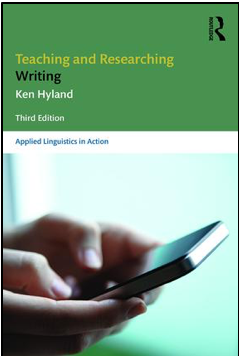Publication Details
| OLOR Series: | ROLE Reviews |
| Author(s): | Kurtis Clements |
| Original Publication Date: | 15 July 2018 |
| Permalink: |
<gsole.org/olor/rolereviews/2018vol1no2.rev6> |
Publication Note
This review was originally published in Research in Online Literacy, vol. 1, no. 2 (2018).
Resource Overview
Media, Figures, Tables |
Resource Contents
Review of Teaching and Researching Writing
The third edition of Ken Hyland’s Teaching and Researching Writing provides a wide-ranging review of the literature on the teaching and researching of writing. The book focuses on what is known about writing, what is known about the teaching of writing, and what has changed in the understanding and teaching of writing since the previous edition. While some of the material discusses familiar territory, the book serves as a comprehensive resource for those engaged with the study of writing—graduate students, writing teachers, and researchers.
The book is divided into three main sections that focus on writing in general, researching writing, and teaching writing. A fourth and final section provides quick takes on significant areas in the field and a collection of resources. What is most helpful are the many examples and case studies used throughout the book followed by Hyland’s critical assessment, commentary, and recommendations. The book is also well organized with helpful “this chapter will discuss” bulleted sections at the start of each chapter, early discussion that connects one chapter or section to the next, and the use of many tables and set-off boxed content to provide examples and additional information. Chapter 8, for example, discusses different approaches to teaching a writing course by looking at “how different conceptions of writing and learning have influenced teaching in real classrooms” (Hyland, 2016, p. 168). In this regard, Hyland shares extended examples of writing classes in New Zealand, Australia, Papua New Guinea, Hong Kong, and England, and the result is a fascinating discussion that reveals how context impacts instruction. The detailed discussion of how writing courses work in such varied but authentic contexts (i.e., real writing classes) shows how theory and practice converge.
While the book covers a lot ground, Hyland does point out in the introduction that what is known about writing and how to teach it is broad in scope. Such discussions, of course, are needed because it provides context to understand what has changed in the field. To understand the present one must recognize the past as the two are inexplicably connected and are what, of course, drive the future. This third edition of the book includes sections that deal with contemporary key issues such as writing and context, writing and technology, and writing and identity. In the Writing and Technology section of Chapter 2, Hyland discusses the tremendous impact technology has had on writing, noting that writing today means communicating meaning in more than just words. In Hyland’s discussion, he references Kress’s contributions to the field in terms of his ideas on multimodality and affordances. One aspect of the book I like most is the use of gray boxes to provide readers with more information. For example, after mentioning Kress, Hyland doesn’t simply skip onward; instead, recognizing that some may need a little more context, Hyland uses a gray box to share a short passage of Kress’s thoughts on affordances and how certain decisions impact meaning before moving forward. Some may find the frequency of these gray boxes a distraction from the discussion, but those readers who do not care to read such content can easily skip over it.
While Hyland does a fine job unifying the discussion and making connections from one part of the text to the next, I did not find the book one that needed to be read section by section or even chapter by chapter. Some may not even find it necessary to read the entire book. In this regard, the reader can skip around and read sections based on interests, and then use the suggestions for further reading or entries from the lengthy list of references to pursue those interests. This is not meant to be a criticism necessarily, as the book is a useful resource, and it is successful at discussing both theory and practice in a way that would appeal to those with some background knowledge of the professional literature and to graduate students.



